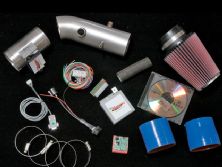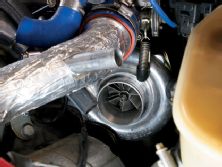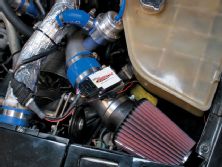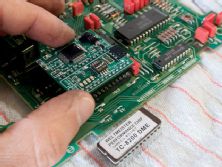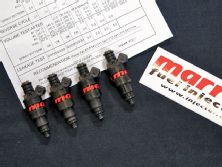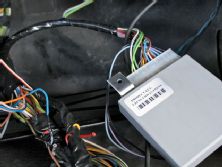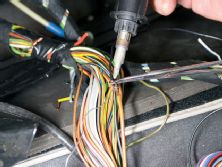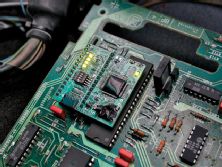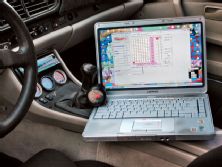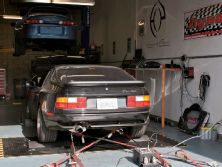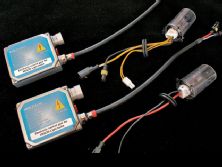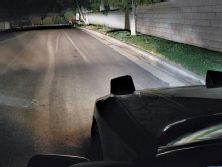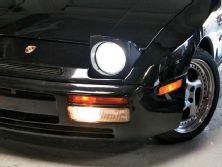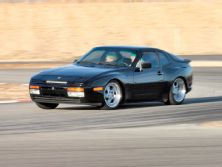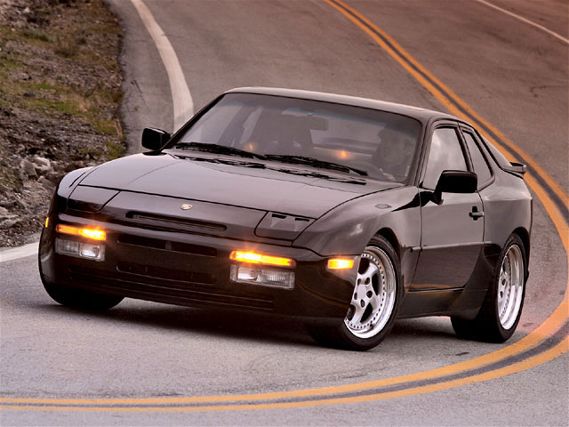 | Porsche 951 - Project
| Porsche 951 - Project
I must admit, Project 951 was taking forever to get going with its motor swap and, after it was ready, we were running into issues that kept slowing things up. Thankfully, Precision Motion-the guys behind the project's recently rebuilt engine-got the gremlins worked out.
While putting on some miles with the Link AFM piggyback system in place, it was difficult to get the car running right. Throttle response seemed a bit hesitant, especially when stomping on it, and the air/fuel curves weren't as crisp as before.
I contacted Vitesse Racing on the East Coast. Why I didn't get these guys involved sooner was my mistake. John Joseph is a real car enthusiast. Thanks to his engineering background, Joseph finds software development, turbo selection and performance enhancing second nature. He met another engineer, Terry Thacker, who also happened to be a car nut and had developed his own advanced tuning solutions. The two formed Vitesse Racing in 2000.
When Project 951 left Stuttgart, it was equipped with a vane air flow meter (VAF), in common with many European cars from the '80s. The DME, or ECU, uses the signal from the VAF to calculate load, fuel and ignition. It worked well, but when engine performance is increased drastically, the VAF becomes a limiting factor.
In Part Four, when we first upgraded the turbo, we switched to the Link piggyback system, which uses a manifold air pressure (MAP) sensor. The problem was that the software tuning made it difficult to achieve a perfect air/fuel ratio. Additionally, since it only tuned the fuel map, we were limited to the ignition maps supplied by the Weltmeister chips in the DME. The Vitesse Mass Air Flow (MAF) kit (which is available for BMW E30 M3, Porsche 944, 951, 944 S2, 911 Carrera and soon the 964) replaces the stock VAF with an MAF. The MAF operates similar to the VAF, but without any moving parts, making its response faster. Most modern high-performance cars use MAF systems.
1. Vitesse Racing blesses Project 951 with its MAF conversion and PiggyBack kit.
2. Our turbo is a Turbonetics 60-1 HiFi with a 0.68 AR housing and P-trim turbine wheel, but we'll be testing the smaller and more streetable 0.58 AR housing on the back side with Turbonetics' new F-165 wheel.
3. The Vitesse intake and MAF housing installed. The pigtail attaches to the factory AFM harness for an easy install. Power the red and ground the black.
4. Vitesse's software chip/board replaces our original Weltmeister chip. Those four switches offer 16 different tuned images, including those for either race fuel or pump fuel.
5. Our 72 lb/hour low-impedance fuel injectors came from Marren Fuel Injection and included a flow data sheet confirming their accuracy.
6. Precision Motion's Kris Kravig installed the injectors.
7. Owner Don Kravig soldered the Vitesse PiggyBack wires to certain sensor wires going to the DME.
8. Now we control the fuel and ignition maps in the Vitesse software.
9. The MAF chip installed. Four little toggle switches allow up to 16 different maps. The green lights indicate which ones are 'on.' In this case, all of them.
The Vitesse MAF kit has several unique features. The sensor is calibrated to Vitesse's specifications, so it can support high-horsepower applications. According to Vitesse, the air/fuel ratio and ignition will always be on target, regardless of boost level, ambient temperature or elevation, because the air mass is measured directly by the MAF, which is then interpreted correctly by the custom Vitesse MAF software in the DME. The software eliminates the need for a piggyback system to modify the MAF signal. Any future upgrades, such as head work and exhaust changes, will automatically be compensated for by the software. The kit can also offer externally selected dual fuel and ignition maps, as well as dual rev limiters, for customers with differing fuel octane requirements.
Normal batch injection with the stock DME software fires all fuel injectors twice per duty cycle. With extra-large injectors, the idle and cruising quality can suffer because the injectors operate at too low a duty cycle. In these instances, Vitesse's software enhances the DME to run in semi-batch mode, which fires the injectors once per cycle, but for twice as long. This gives larger injectors time to work optimally in these low-flow conditions. The software automatically switches between batch and semi-batch operation as necessary while the engine is running. The end result is a smoother idle and crisper response, even when running injectors up to 83 lb/hr.
The MAF software chip/board itself is a neat feature. Vitesse uses in-house hardware, using the chip/board in place of the generic EPROM chip inside the DME. The chip/board can house up to 16 individual images, whereas the original EPROM chip houses only one. The multiple-image setup is beneficial for customers planning to upgrade in the future.
Vitesse also offers its PiggyBack unit for even more custom tuning. "We have yet to see two cars that are 100 percent identical. Our MAF software gets on target, but our PiggyBack is used to customize the system to the customer's unique application. Many customers use only the Vitesse MAF kit without this, but the PiggyBack will offer even more flexibility," says John Joseph.
10. Getting to work on the software tuning. In this picture, I'm playing with the fuel mapping a bit and I have the idle close to where I want it, per the AEM air/fuel gauge.
11. On House of Power's Dynojet 224x dyno. Without a boost controller, it's stuck at 14 psi (17 psi on the street). We saw 280 wheel-hp at this boost level to start, but we'll see more boost and power with a boost controller next time.
12. A while back, the good people at Umnitza sent these lights. While they don't deal with HID retrofit kits, they can help you obtain them from authorized distributors (where it's legal to do so).
13. The 6000k bulbs in Umnitza's xenon kit really light up the road at night.
Vitesse's PiggyBack is a computer that connects to the engine sensors, modifying their output prior to reaching the DME. By manipulating the signals, it's possible to alter the output of the DME. The range of modifications is kept to a minimum in order to keep the signals within an accurate range. Much like a standalone engine management system, it features two- and three-dimensional control over fuel and optional ignition, data logging, and externally selected dual settings. "The data logging feature is a great tool, it simplifies tuning and allows us to assist remote customers as if we were on site," says Joseph.
Back at Precision Motion, owner Don Kravig spent the time soldering and heat-shrinking the wires for a clean installation of the Vitesse kit. When the car was fired up, it ran fairly well from the get-go. That was impressive, given that Vitesse made the fuel maps just by looking at a dyno sheet I had sent them. Using my AEM gauge-type, wide-band oxygen sensor, I was able to dial in the ideal air/fuel ratio within minutes. I had to do this because we had a new cam and a slightly reworked cylinder head since that dyno graph.
And I had given Vitesse the wrong injector information. I said they were 50 lb/hour, which was about right, but they were high impedance and the DME is set to drive low impedance injectors. How the car ever ran for this long is a mystery.
It was obviously time to order a new set of injectors and Marren Fuel Injection was the place to go. These guys sell practically anything fuel-related and they're highly knowledgeable. Because we felt confident we'd get the car to idle well and wanted to leave room for an improvement in power, we ordered 72 lb/hour (750cc/min) low impedance injectors, which, thankfully, Vitesse had built an option for in its MAF software. All I had to do was toggle the switches on the chip/board to the right combo.
The fine-tuning part of the fuel curve was fairly easy, although Joseph gave me a thorough walk-through. The one thing I really noticed was the smoothness at part-throttle that I had a hard time getting with the previous system. This gives us a good starting point with this newly broken-in engine.
Unfortunately, we have a turbocharger that needs rebuilding, so back to Turbonetics. I suspect insufficient lubrication is the culprit and plan to address this next. On the street, Project 951 has been making 17 psi off the Tial 44mm wastegate, thanks to the 1-bar larger Tial wastegate spring with a 0.2-bar inner spring that I added. But just like on the last Dynojet 224x loading dyno, House of Power's 224x only allowed 14 psi. And that's where it'll stay until I get a boost controller. Even with the ill turbo, 280 wheel-hp is possible at this modest boost level.
The current owner of Project 951 (reluctantly, I sold it last year) hopes to get some more mid-range performance. Maybe it doesn't help that he has his 997 S to compare it to. Turbonetics will be sending our unit back, doing away with the 0.68 P-trim housing and going with a 0.58 aspect ratio housing with Turbonetics' new P-trim replacement inside, the F-165 turbine wheel.
In the meantime, we'll also put on a boost controller, splash some racing fuel, reset the Vitesse software to the 100-octane program and hope for a few good rips on the dyno.

